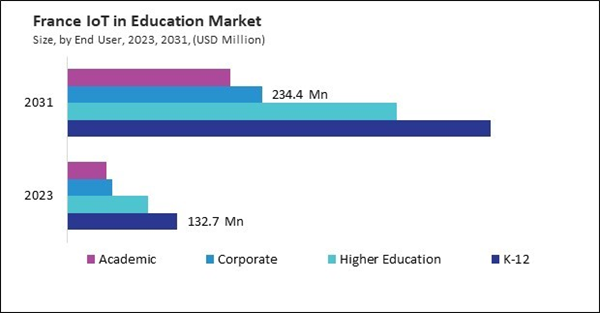The Europe IoT in Education Market is expected to witness market growth of 18.9% CAGR during the forecast period (2024-2031).
The Germany market dominated the Europe IoT in Education Market by Country in 2023, and is expected to continue to be a dominant market till 2031; thereby, achieving a market value of USD2.23 billion by 2031. The UK market is exhibiting a CAGR of 17.8% during 2024-2031. Additionally, the France market would experience a CAGR of 19.8% during 2024-2031.
IoT sensors can track student behavior and engagement levels during lessons, helping educators understand the most effective teaching methods. By analyzing data collected from IoT devices, educators can identify students at risk of falling behind and implement proactive measures to support them. IoT technology can enhance campus security with smart locks that grant access based on user credentials, ensuring that only authorized individuals can enter specific areas.
Additionally, connected devices can alert authorities during emergencies, providing real-time information about incidents, thereby improving response times and safety protocols. IoT devices can monitor the usage of facilities and equipment, enabling institutions to allocate resources more efficiently and reduce waste. Automated systems track the availability and usage of educational materials and supplies, ensuring that resources are replenished as needed without overstocking.
The rising adoption of Internet of Things (IoT) devices and the increasing digitalization in education significantly impacts the IoT in education market across Europe. As per the Eurostat, in 2021, approximately 29% of EU enterprises utilized IoT devices to enhance security within their facilities. Notably, the adoption rate varied significantly between large and small enterprises, with 48% of large enterprises employing IoT technologies compared to only 26% of small enterprises. This gap indicates a substantial opportunity for smaller institutions to integrate IoT solutions, which could transform their educational offerings and operational efficiencies.
The Germany market dominated the Europe IoT in Education Market by Country in 2023, and is expected to continue to be a dominant market till 2031; thereby, achieving a market value of USD2.23 billion by 2031. The UK market is exhibiting a CAGR of 17.8% during 2024-2031. Additionally, the France market would experience a CAGR of 19.8% during 2024-2031.
IoT sensors can track student behavior and engagement levels during lessons, helping educators understand the most effective teaching methods. By analyzing data collected from IoT devices, educators can identify students at risk of falling behind and implement proactive measures to support them. IoT technology can enhance campus security with smart locks that grant access based on user credentials, ensuring that only authorized individuals can enter specific areas.
Additionally, connected devices can alert authorities during emergencies, providing real-time information about incidents, thereby improving response times and safety protocols. IoT devices can monitor the usage of facilities and equipment, enabling institutions to allocate resources more efficiently and reduce waste. Automated systems track the availability and usage of educational materials and supplies, ensuring that resources are replenished as needed without overstocking.
The rising adoption of Internet of Things (IoT) devices and the increasing digitalization in education significantly impacts the IoT in education market across Europe. As per the Eurostat, in 2021, approximately 29% of EU enterprises utilized IoT devices to enhance security within their facilities. Notably, the adoption rate varied significantly between large and small enterprises, with 48% of large enterprises employing IoT technologies compared to only 26% of small enterprises. This gap indicates a substantial opportunity for smaller institutions to integrate IoT solutions, which could transform their educational offerings and operational efficiencies.
List of Key Companies Profiled
- SAP SE
- Intel Corporation
- Huawei Technologies Co., Ltd. (Huawei Investment & Holding Co., Ltd.)
- IBM Corporation
- Amazon Web Services, Inc. (Amazon.com, Inc.)
- Oracle Corporation
- Google LLC (Alphabet Inc.)
- Cisco Systems Inc.
- Microsoft Corporation
- Samsung Electronics Co., Ltd. (Samsung Group)
Market Report Segmentation
By Component
- Hardware
- Solution
- Network Management
- Content Management and Analytics
- Device Management
- Security Management
- Application Management
- Services
- Deployment & Integration
- Professional Services
- Support & Maintenance
- Training & Consulting
- Managed Services
By End User
- K-12
- Higher Education
- Corporate
- Academic
By Application
- Learning Management System
- Classroom Management
- Administration Management
- Surveillance
- Other Application
By Country
- Germany
- UK
- France
- Russia
- Spain
- Italy
- Rest of Europe
Table of Contents
Chapter 1. Market Scope & Methodology
Chapter 2. Market at a Glance
Chapter 3. Market Overview
Chapter 4. Competition Analysis - Global
Chapter 5. Europe IoT in Education Market by Component
Chapter 6. Europe IoT in Education Market by End User
Chapter 7. Europe IoT in Education Market by Application
Chapter 8. Europe IoT in Education Market by Country
Chapter 9. Company Profiles
Companies Mentioned
Some of the key companies in the Europe IoT in Education Market include:- SAP SE
- Intel Corporation
- Huawei Technologies Co., Ltd. (Huawei Investment & Holding Co., Ltd.)
- IBM Corporation
- Amazon Web Services, Inc. (Amazon.com, Inc.)
- Oracle Corporation
- Google LLC (Alphabet Inc.)
- Cisco Systems Inc.
- Microsoft Corporation
- Samsung Electronics Co., Ltd. (Samsung Group)
Methodology

LOADING...









